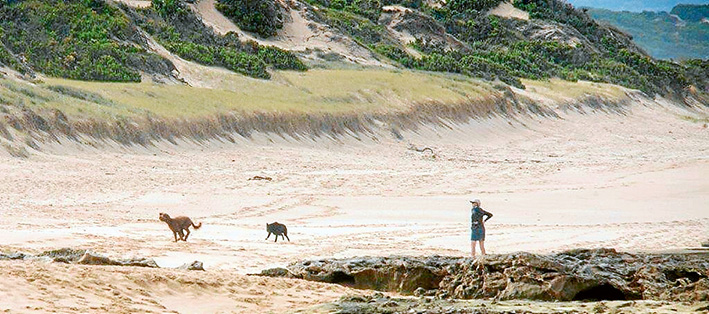MORNINGTON Peninsula Shire is under pressure to set aside more leash-free areas before dogs are banned from beaches between Flinders and Point Nepean.
The total ban on dogs on beaches within the Mornington Peninsula National Park comes into effect in November.
As well as banning dogs, the measures to protect the endangered hooded plover may also include laying poison baits for foxes and trapping feral cats.
Groups that effectively lobbied the state government for the dog ban are now campaigning for more leash-free areas close to the beaches.
The seasoned hooded plover campaigners dispute assurances from Mornington Peninsula Shire that the number of leash-free areas on the southern peninsula is adequate.
Privately, they say the shire has a negative reaction to being told what to do by the state government.
When announcing the dog ban Environment, Climate Change and Water Minister Lisa Neville said many people were walking their dogs through hooded plover breeding areas despite restrictions being tightened in 2013.
“The evidence shows that dogs and hooded plovers don’t mix. This ban is the right decision to protect a vulnerable and threatened species for which the Mornington Peninsula National Park is an important habitat,” Ms Neville said.
The losses of eggs and chicks by breeding hooded plovers have increased dramatically with just five chicks fledging from 245 eggs during the past two breading seasons.
BirdLife Australia data shows that 70 per cent of hooded plover chicks were successfully fledged in areas where dogs are prohibited.
The groups, which have spent nine years fighting for the plovers, credit the political lobbying of South Eastern Centre for Sustainability president Steve Karakitsos with the ban being brought in five years earlier than expected.
Mr Karakitsos wants a meeting between the shire, BirdLife representatives and Dogwalking Victoria.
“The reality is that there are absolutely no leash free areas adjacent to the MPNP for dog walkers to access once [the dog ban is] put into effect,” Mr Karakitsos stated last week in an email to the shire.
He said three areas suitable for dogs to be leash-free have been identified by Dr Grainne Maguire of BirdLife Australia.
Mr Karakitsos said declaring extra leash-free areas for dogs would allow a “seamless implementation” of the dog ban.
“The shire does not operate within a vacuum and according to Holding Redlich Lawyers is a responsible authority operating under jurisdiction of the Victorian State [and] has a responsibility to adhere to and [is] liable to prosecution for failure to act reasonably and responsibly,” Mr Karakitsos said.
He said Dr Maguire was completing a paper which “shows compliance is significantly higher on dog prohibited beaches and that off leash dog beaches do attract more dog walkers, shifting them in the local landscape to these areas. Hence the need to ensure enough of these are provided”.
Diane Lewis, president Friends of the Hooded Plover (Mornington Peninsula), feels “very sorry” for dog owners who obeyed the existing dog restrictions.
“Many of our members will be affected by this decision. They too will need to find alternative places to walk their dogs,” Ms Lewis said.
“It is now up to the shire to provide suitable off leash areas for residents to exercise their dogs.
“I estimate with over 25,000 dogs costing $35 each year to be registered, the shire collects in excess of $800,000. It is time some of this income is used for the benefit of all dog owners by providing the necessary spaces for their pets’ wellbeing.”
The national park includes the coast between London Bridge and Bushrangers Bay, plus a stretch from Stockyard Creek to Flinders, and also an area north of Cape Schanck called Greens Bush.
Until 1 November, dog walking is allowed in about 14 kilometres of the park’s 42-kilometre coastline.
First published in the Southern Peninsula News – 22 March 2016




